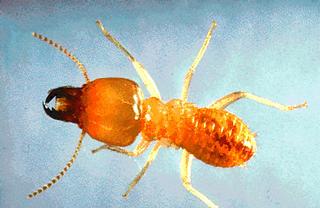 |
Order
- ISOPTERA
(Greek, isos = equal; pteron =
wing)
Common Names: termites, white ants
Distribution: Cosmopolitan, mostly tropical
and subtropical
Description
There are about 2,300 species of these soft-bodied, social insects
worldwide. Antennae are usually well developed and composed of very short,
bead-like segments (moniliform). Mandibles are always well developed.
Compound eyes may be present but are frequently reduced. Termites have a
series of castes: workers, soldiers, queens and kings. Soldiers form two
main groups: those with well developed mandibles for defence against
enemies and those with a pronounced "snout" (nasus) through
which sticky defensive secretions are ejected at the enemy. Wings are only
present in reproductive castes and only for a short period. Wings are
elongate, membranous and held flat over the body at rest. The wings have
lines of weakness at their bases and are shed after dispersal from the
termite mound. Many termite species consume wood or plant material but by
themselves are incapable of cellulose digestion. Their gut flora contains
symbiotic protozoans which are able to break down the cellulose and enable
the termites to benefit from their diet. Without the social behaviour of
these insects which involves food exchange between individuals,
inoculation of the symbionts into newly hatched or moulted individuals
would not occur.
Nymph
No metamorphosis occurs (e.g. egg-larva-pupa-adult); the newly hatched
individual is a wingless nymph and may develop into any caste required by
the colony.
Members
Termites or white ants.
Food
Wood or plant material of any kind including grass stems, old weathered
dung pats or plant litter. Cellulose is digested by symbiotic protozoans
in the termite gut. Some termite species cultivate fungi on the stored
cellulose and feed on the fruiting bodies produced.
Importance
The destructive effects of termites on buildings is well known. Huge sums
of money are expended annually to prevent termite infestations or to
repair the damage done by these insects if they have invaded homes or
other structures. Damage in tropical areas is especially severe unless
care is taken with building design. Extremely toxic chemicals such as
chlordane or lindane have been used in the past to combat termites but
these substances are now banned from general use as they are extremely
persistent in the environment. Tropical species of Australian eucalypts
actually benefit from termite infestation. Once the dead heartwood is
removed by the termite colony, the living sapwood forms a rigid cylinder
which remains quite strong, enough to support the weight of the tree. The
resulting hollow is often used by various animals whose droppings provide
quantities of fertilizer for the tree for many years. |